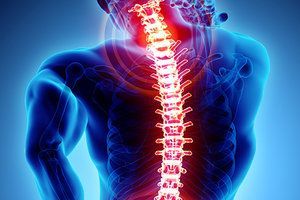One of the longest nerves in the body is known as the vagus nerve (VN). The VN is the 10th pair of cranial nerves that originates at the brain stem in the medulla oblongata. This nerve is part of the parasympathetic nervous system, which is a part of the ANS. Research suggests ear acupuncture can activate the VN.
Electrotherapy Gives Hope for Patients With Spinal Cord Injury
There has been little optimism for recovery from a spinal cord injury because the central nervous system does not repair itself well. The severity of the injury depends on the affected area. Loss of impulse conduction disrupts an individual's ability to move limbs, stand and walk. Injury also results in loss of various bodily functions depending upon the level of injury. Treatment following a spinal cord injury comprises immobilizing the spinal cord to prevent further harm, medication and various types of rehabilitation programs.
Spinal Cord Injury & Electrotherapy
Electrotherapy is defined as the therapeutic use of low-level current for pain and soft tissue injury. Funding for research in this field diminished greatly as the pharmaceutical industry grew and prospered. But now, the pendulum is swinging back as cutting-edge developments in electrotherapy research are igniting hope for treating paralysis. This is especially evident when treatment pairs electrotherapy with physical therapy.
In 2017, researchers at the renowned Mayo Clinic embedded a tiny electrode into the spinal cord of a paralyzed patient. The electrode was connected to a "computer-controlled device" under the skin of the patient's abdomen. This device sent electrical impulses to the spinal cord. Along with physical therapy, the patient regained his ability to stand and take a few steps with assistance.

"What this is teaching us is that those networks of neurons below a spinal cord injury still can function after paralysis," said Kendall, Lee, Neurosurgeon and Director of the Mayo Clinic's Neural Engineering Laboratory. According to Dr. Lee, the patient continues to make progress.
Research on the Horizon
Electrotherapy is such a promising field that Alphabet, the parent company of Google is collaborating with the giant pharmaceutical company, GlaxoSmithKline (GSK) investing millions of dollars in research. They are wagering that electrotherapy will play an important role in the future treatment of spinal cord injuries as well as treatment for chronic diseases such as diabetes and arthritis.
In another study at the Mayo Clinic, researchers used electrical stimulation with physical therapy to treat a 26-year-old patient who had an injury at the sixth thoracic vertebrae. The combined therapies helped the patient move his legs for the first time in three years. According to researchers, these results offer evidence that a combination of electrical stimulation and rehabilitation may help patients recover control over previously paralyzed movements such as standing and the ability to maintain balance.
A 2014 study by the University of Louisville funded in part by the Christopher and Dana Reeve Foundation, and the National Institutes of Health involved four men with incomplete spinal injuries. An incomplete injury is partial damage to the spinal cord with some remaining motor and sensory function. Patients were surgically implanted with an epidural stimulator, which sends electrical signals to select areas of the spinal cord. The intensity of the current was controlled by a small remote device connected to the stimulator. The patient manually controlled the remote, which allowed for the performance of various movements.
When the device was on, the patients were able to flex their toes, ankles, and knees, and move their legs, stand up and take steps. There was more regulation over bowel, bladder, and sexual function. "What often kills people living with spinal cord injuries is these secondary injuries like bedsores and infections," says Peter Wilde Rotter, CEO of the Reeve Foundation.
"What we have uncovered is a fundamentally new intervention strategy that can affect voluntary movement in people with complete paralysis, even years after their injury," says Susan Harkema, rehabilitation research director at the Kentucky Spinal Cord Injury Research Center at the University of Louisville and the Frazier Rehab Institute.
In another study with six quadriplegic patients, Dr. Reggie Edgerton, UCLA, NRT (NeuroRecovery Technology) used noninvasive transcutaneous electrical stimulation (through the skin) as opposed to implantation of an electrical device. The unit was placed on the upper body to restore upper extremity function. He report-ed that patients regained "significant functions" and results were "quite remarkable."
Dr. Gregoire Courtine's research in Switzerland has only applied electrical stimulation on animals with acute injuries. Courtine combined electrical stimulation with a "chemical cocktail" to achieve results. Rats with an acute spinal cord injury were able to step on a treadmill following stimulation. It is hoped that his "system" could be applied for patients with incomplete spinal cord injuries. Additional studies using electrotherapy devices for spinal cord injury are documented on the PubMed.gov website, NCBI (US National Library of Medicine National Institute of Health).5
Resources
- Angeli CA, Edgerton VR, et al. Altering spinal cord excitability enables voluntary movements after chronic complete paralysis in humans. Brain, 2014 May;137(Pt 5):1394-409.
- Sayenko DG, Angeli C, et al. Neuromodulation of evoked muscle potentials induced by epidural spinal-cord stimulation in paralyzed individuals. J Neurophysiol, 2014 Mar;111(5):1088-99.
- Jeanmaire C. Progress and Prospects of Chronic Spinal Cord Injury Research in 2015 and 2016. Paralysis Foundation and for the ESCIF (European Spinal Cord Federation) Research Group, March 2016.
- Courtine G. A brain spinal interface to alleviate lower limb deficits after neuromotor disorders. Society for Neuroscience Chicago 2015 Sensorimotor Neuroprosthetics Brain-Machine Interface, November 27, 2015.
- University of Louisville, UCLA and the Pavlov Institute of Physiology May, 2014.



